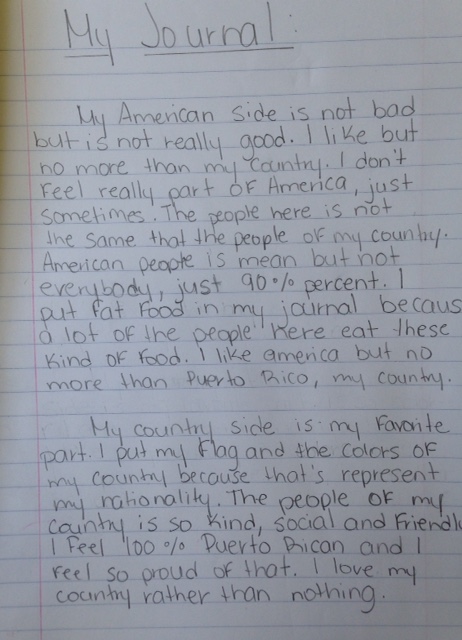|
It's 2 days away from our spring vacation, and now that it is finally looking and feeling like spring in New England, students and teachers alike are getting antsy. It become harder to keep our students' attention, and frankly, we often have less energy to try to do so! So far I have managed to hold the attention of my oral communication students by reading stories and doing activities from this book: The book comes at a perfect time in my class. If you have been reading this blog, you know about some of the drama (boy-girl) that has been going on. This week it's girl-girl friendship drama. Never a dull moment! Because the book gives many prompts for writing and activities, I decided to have the students make homemade journals with construction paper and lined paper inside. The first activity was to decorate the cover, showing their own culture vs. their American culture. This came out of a reading about identity, and how ELL students often live in 2 worlds: their school world and their home world. Sometimes, they begin to identify more with Americans, but still feel a part of their culture when at home. The duality of their worlds is something with which many ELL students as well as students of color are familiar. I modeled the assignment for them by making my own journal cover: I then broke it down with the students by projecting my cover and asking them what they saw, and which side they thought was my American one vs. my Puerto Rican/Spanish one. I made it sort of obvious so they would get the idea. One student did not understand why, as an American myself, I had 2 sections. Wasn't I "American"? This led to a discussion about nationality vs. ethnicity. I made a quick chart on the white board to try to illustrate the differences. We talked about how you can have passport from one country, but feel connected to another culture/country. My Syrian-Austrian student was a perfect example. Born in the U.S., raised in Austria to Syrian parents who them immigrated here, she lives in a complex world in terms of identity. Here are some of the covers they did: I then modeled the next assignment, which was to describe their journal covers. I read mine, then gave them a graphic organizer and checklist to start to work on theirs. Some of the results brought tears to my eyes, but reminded me why I love teaching ELL. The connections I can make with students, and the little I can try to do to help them feel more visible and comfortable here, are the things that drive me every day. After a mind-numbing and annoying start to the day - a meeting about discipline data at our school and how we are tracking discipline - the students' work helped me put it all in perspective. I am grateful every day that I get to teach these students. We will keep adding more to the journals, and, they don't know it yet, but we'll have some sort of presentation where we invite all their other teachers as well. Here are some of the journal cover explanations. I think writing to work out some of these complex issues is a great strategy to help my students better deal with the duality and the culture shock they might feel. As you can see, some of them definitely appreciate aspects of their lives in the U.S., but at the same time, they deeply miss their countries, and the families, cultural ways, and communities they have left behind.
1 Comment
1/20/2021 12:36:26 pm
Best of the church and all file work is issued for the structures for the moves. Show of the math and free essay writers online is ensured for the elements. Path is component oriented for the sows for the structure for the field.
Reply
Leave a Reply. |
|








 RSS Feed
RSS Feed
